See the display needs of a school department
Write a program to display the department structure of a school: the demand is that the Department composition of the school should be displayed on one page. A school has multiple colleges and a college has multiple departments. As shown in the figure:
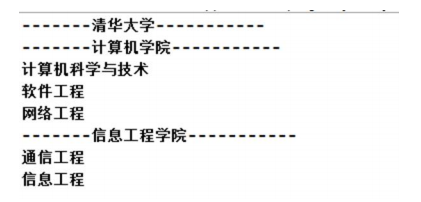
Traditional solution school department display (class diagram)
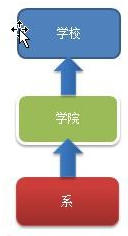
Analysis on the problems existing in the display of schools and departments with traditional solutions
- The college is regarded as a subclass of the school, and the Department is a subclass of the college. In fact, it is hierarchical based on the size of the organization
- In fact, our requirement is to display the composition of colleges and departments of the school in one page. A school has multiple colleges and a college has multiple departments. This scheme can not well realize the management operations, such as adding, deleting, traversing, etc. of colleges and departments
- Solution: schools, colleges and departments are regarded as organizational structures. There is no inheritance relationship between them, but a tree structure, which can better realize management operations. = > Combination mode
Basic introduction to combination mode
- Composite Pattern, also known as partial overall pattern, creates a tree structure of object groups and combines objects into a tree structure to represent the hierarchical relationship of "whole part".
- The combination mode combines objects according to the tree structure, which is used to represent the partial and overall levels.
- This type of design pattern belongs to structural pattern.
- The combination mode makes the user's access to single objects and combined objects consistent, that is, combination allows customers to deal with individual objects and combined objects in a consistent way
Schematic class diagram of combined mode
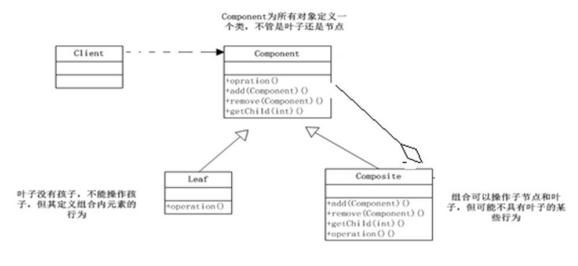
Description of schematic structure diagram - i.e. (roles and responsibilities of combination mode)
- Component: This is the object declaration interface in the composition. If appropriate, it implements the default behavior of the interface common to all classes for access and management
Component subassemblies, which # can be abstract classes or interfaces
- Leaf: represents a leaf node in a combination. A leaf node has no child nodes
- Composite: a non leaf node, which is used to store subcomponents and implement related operations of subcomponents in the Component} interface, such as add and delete.
Application example of combination mode to solve the display of school departments
Application example requirements
- Write a program to display the department structure of a school: the demand is that the Department composition of the school should be displayed on one page. A school has multiple colleges and a college has multiple departments.
- Train of thought analysis and illustration (class diagram)
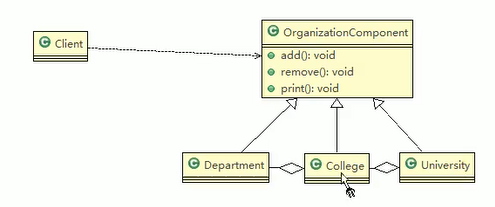
- code implementation
package com.atguigu.composite; /** * @Author panghl * @Date 2021/6/26 11:43 * @Description TODO **/ public abstract class OrganizationComponent { private String name; private String des; protected void add(OrganizationComponent component){ //Default implementation throw new UnsupportedOperationException("Operation not supported"); } protected void remove(OrganizationComponent component){ //Default implementation throw new UnsupportedOperationException("Operation not supported"); } //constructor public OrganizationComponent(String name, String des) { super(); this.name = name; this.des = des; } public String getName() { return name; } public void setName(String name) { this.name = name; } public String getDes() { return des; } public void setDes(String des) { this.des = des; } //The method print is made abstract, and subclasses need to be implemented protected abstract void print(); }package com.atguigu.composite; import java.util.ArrayList; import java.util.List; /** * @Author panghl * @Date 2021/6/26 11:46 * @Description University It is Composite, which can manage the College **/ public class University extends OrganizationComponent { List<OrganizationComponent> organizationComponents = new ArrayList<>(); public University(String name, String des) { super(name, des); } @Override protected void add(OrganizationComponent component) { organizationComponents.add(component); } @Override protected void remove(OrganizationComponent component) { organizationComponents.remove(component); } @Override public String getName() { return super.getName(); } @Override public String getDes() { return super.getDes(); } //The print method is to output the colleges included in the University @Override protected void print() { System.out.println("==========="+super.getName()+"========"); //Traverse organizationComponents for (OrganizationComponent organizationComponent : organizationComponents) { organizationComponent.print(); } } }package com.atguigu.composite; import java.util.ArrayList; import java.util.List; /** * @Author panghl * @Date 2021/6/26 11:52 * @Description TODO **/ public class College extends OrganizationComponent { //Department stored in List List<OrganizationComponent> organizationComponents = new ArrayList<>(); public College(String name, String des) { super(name, des); } @Override protected void add(OrganizationComponent component) { //In the actual business in the future, College add and University add may not be exactly the same organizationComponents.add(component); } @Override protected void remove(OrganizationComponent component) { organizationComponents.remove(component); } @Override public String getName() { return super.getName(); } @Override public String getDes() { return super.getDes(); } //The print method is to output the colleges included in the University @Override protected void print() { System.out.println("==========="+super.getName()+"========"); //Traverse organizationComponents for (OrganizationComponent organizationComponent : organizationComponents) { organizationComponent.print(); } } }package com.atguigu.composite; import java.util.ArrayList; import java.util.List; /** * @Author panghl * @Date 2021/6/26 11:54 * @Description TODO **/ public class Department extends OrganizationComponent { //The collection is gone public Department(String name, String des) { super(name, des); } @Override public String getName() { return super.getName(); } @Override public String getDes() { return super.getDes(); } //Add and remove do not need to be written because they are leaf nodes @Override protected void print() { System.out.println(getName()); } }package com.atguigu.composite; /** * @Author panghl * @Date 2021/6/26 11:56 * @Description TODO **/ public class Client { public static void main(String[] args) { //Create object school from Avenue OrganizationComponent university = new University("Tsinghua University","First class universities in China"); //Create College OrganizationComponent college1 = new College("school of computing", "Cheng xuape"); OrganizationComponent college2 = new College("School of Information Engineering", "Lead wire"); //Create departments (majors) under each college OrganizationComponent department1 = new Department("software engineering", "software development"); OrganizationComponent department2 = new Department("Computer science and technology", "Computer science and technology"); OrganizationComponent department3 = new Department("Network engineering", "Network engineering"); OrganizationComponent department4 = new Department("communication engineering", "communication engineering"); college1.add(department1); college1.add(department2); college2.add(department3); college2.add(department4); university.add(college1); university.add(college2); university.print(); } }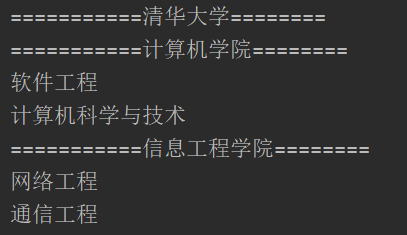
Source code analysis of composite pattern in JDK set
- The Java collection class HashMap uses the composite pattern
- Code analysis + Debug source code

Class diagram:
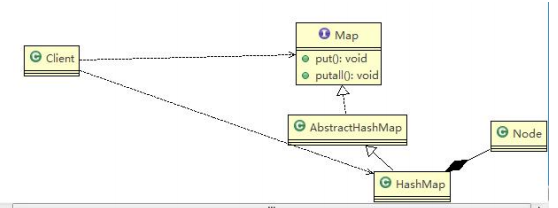
package com.atguigu.jdk;
import java.util.HashMap;
import java.util.Map;
/**
* @Author panghl
* @Date 2021/6/26 12:08
* @Description TODO
**/
public class Composite {
public static void main(String[] args) {
/**
* explain
* 1,Map It is an abstract build (similar to our Component)
* 2,HashMap Is an intermediate composite that implements / inherits related methods
* put,putAll
* 3,Node It is a static internal class of HashMap, similar to the Leaf node of Leaf. There are no put and putall here
* static class Node<K,V> implements Map.Entry<K,V>
*/
Map<String, String> map1 = new HashMap<>();
map1.put("0","Journey to the East");
Map<String, String> map2 = new HashMap<>();
map2.put("1","Journey to the West");
map2.put("2","The Dream of Red Mansion");
map1.putAll(map2);
System.out.println(map1);
}
}
Notes and details of combination mode
- Simplify client operations. The client only needs to face consistent objects without considering the whole part or node leaf.
- It has strong scalability. When we want to change the composite object, we only need to adjust the internal hierarchical relationship, and the client does not need to make any changes
- Facilitate the creation of complex hierarchies. The client does not care about the composition details in the composition, and it is easy to add nodes or leaves to create a complex tree structure
- When you need to traverse the organization, or the object you are dealing with has a tree structure, it is very suitable to use the composite mode
- It requires high abstraction. If there are many differences between nodes and leaves, for example, many methods and attributes are different, it is not suitable to use composite mode